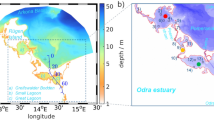Abstract
The analysis of nutrient budgets is a common method for assessing the biogeochemical function of estuaries including denitrification and nutrient retention rates. The Land Ocean Interactions in the Coastal Zone (LOICZ) guidelines for constructing such budgets concentrate on the simplest case where an estuary or embryment is treated as a single box which is well-mixed both vertically and horizontally and at steady-state. We show that these simplifying assumptions can lead to significant and sometimes very large errors in estimates of internal retention (or production) rates. If the load to an estuary varies significantly through the year, the use of time-averaged concentrations of nutrient and salinity to calculate retention rates is shown to cause errors of up to 30% depending on the circumstances. The second case considered examines the consequences of treating an estuary which has significant long-estuary salinity and nutrient gradients as a well-mixed box. In a simple case considered, the calculated internal production from a distributed source is underestimated by a factor of two. The errors are shown to depend on the estuary's mixing and geometrical characteristic as well as on the location of the nutrient sources. The third case considers the errors in the calculated internal retention/production rates of treating an estuary with a two-layer circulation as a single-box system. The potential errors are severe. A comparison between a one-box analysis and a two-box analysis which accounts for the true estuarine circulation shows that the two analyses can yield calculated retention rates of opposite sign. In this situation, one configuration for the estuary would appear to sequester nutrient, whereas the other would be a net exporter of nutrient.
Similar content being viewed by others
Literature Cited
Boyle, E., R. Collier, A. T. Dengler, J. M. Edmond, A. C. Ng, andR. F. Stallard. 1974. On the chemical mass-balance in estuaries.Geochimica et Cosmochimica Acta 38:1719–1728.
Dyer, K. H. 1973. Estuaries: A Physical Introduction. John Wiley and Sons, London.
Gordon, Jr.,D. C., P. R. Boudreau, K. H. Mann, J.-E. Ong, W. L. Silvert, S. V. Smith, G. Wattavakom, F. Wulff, andT. Yanagi. 1996. LOICZ Biogeochemical Modelling Guidelines. LOICZ/R&S/95-5. Land Ocean Interactions in the Coastal Zone. Texel, The Netherlands.
Kaul, L. W. andP. N. Froelich, Jr. 1984. Modeling estuarine nutrient geochemistry in a simple system.Geochimica et Cosmochimica Acta 48:1417–1433.
Loder, T. C. andR. P. Reichard. 1981. The dynamics of conservative mixing in estuaries.Estuaries 4:64–69.
Maeda, H. 1952. The relation between chlorinity and silicate concentration of water observed in some estuaries.Publications of the Seto Marine Biological Laboratory 2:249–255.
Officer, C. B.. 1979. Discussion of the behavior of nonconservative dissolved constituents in estuaries.Estuarine, Coastal and Marine Science 9:91–94.
Officer, C. B. 1980. Box models revisited, p. 65–114.In P. K. Hamilton and K. B. Macdonald (eds.), Estuarine and Wetland Processes. Plenum, New York.
Officer, C. B. andD. R. Lynch. 1981. Dynamics of mixing in Estuaries.Estuarine, Coastal and Shelf Science 12:525–533.
Pritchard, D. W. 1969. Dispersion and flushing of pollutants from estuaries.Proceedings of the American Society of Civil Engineers 95:115–124.
Smith, S. V., andM. J. Atkinson. 1994. Mass balance of nutrient fluxes in coastal lagoons, p. 133–155.In B. Kjerfve (ed.), Coastal Lagoon Processes. Elsevier, Amsterdam.
Smith, S. V. andJ. T. Hollibaugh. 1997. Annual cycle and interannual variability of net and gross ecosystem metabolism in a temperate climate embayment.Ecological Monographs 67: 509–533.
Taft, J. L., A. J. Elliott, andW. R. Taylor. 1978. Box model analysis of Chesapeake Bay ammonium and nitrate fluxes, p. 115–130.In M. L. Wiley (ed.), Estuarine Interactions. Academic, New York.
Wulff, F. andA. Stigebrandt. 1989. A time-dependent budget model for nutrients in the Baltic Sea.Global Biogeochemical Cycles 3:63–78.
Author information
Authors and Affiliations
Corresponding author
Rights and permissions
About this article
Cite this article
Webster, I.T., Smith, S.V. & Parslow, J.S. Implications of spatial and temporal variation for biogeochemical budgets of estuaries. Estuaries 23, 341–350 (2000). https://doi.org/10.2307/1353326
Received:
Accepted:
Issue Date:
DOI: https://doi.org/10.2307/1353326




